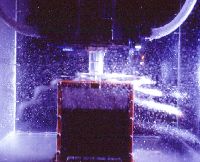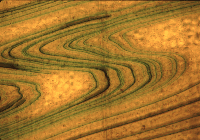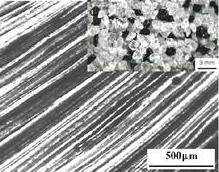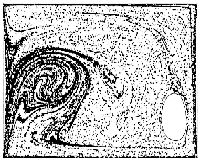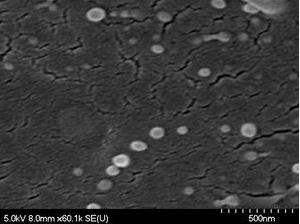-
LAPM&T is the birthplace of polymer blends and composites formed
by chaotic advection (chaotic mixing). First studies were conducted with funds
provided by the National Science Foundation with work begun in 1991.
Thermoplastic blends have been made with novel morphologies such as
those consisting of large numbers of layers, interpenetrating
phases, fibers, selective or low permeability structures, and very
fine droplets even at adverse viscosity ratios. Solid additives also have
been placed into functional structures such as percolating networks
to render plastics electrically conducting at unusually low additive concentrations.
Nanoplatelets have been oriented and selectively placed in thermoplastic
matrices to enhance physical properties. The Laboratory has produced the
most highly multi-layered extrusions ever made, with individual layer thicknesses
less than a few nanometers. Such extrusions can have 10's of thousands of
internal layers. Following first fundamental studies, concepts were
converted to practical processes and the first patent in this area was awarded
with others issuing or pending (e.g., Chaotic Mixing Method and Structured
Materials Formed Therefrom, United States Patent Number 6,770,340 B2,
August 3, 2004, Inventors: David A. Zumbrunnen and Ojin Kwon).
- It was first demonstrated that materials with internal nanoscale dimensions
(i.e., nanocomposites) can be formed when material components are in a liquid-like
condition and are subjected to chaotic advection. For example, where
two polymer melts are placed within a cavity where chaotic advection can be
instilled, the melts will undergo recursive stretching and folding so that
nanoscale dimensions can be eventually reached. Alternately, as done in LAPM&T
smart blending machines, these conditions can be instilled as the combined
melt moves toward an extrusion point so that nanocomposite materials can
be extruded and produced in large quantities. The application of these concepts
to attain molecular scale dimensions to give molecular composites was also
described.
-
Due to mixing-based processing, plastic materials which consist of
more than one polymer type or include solid additives are not necessarily
optimized with regard to structure, properties, and composition.
To address these shortcomings, smart blending technology was proposed
as a potential non-incremental advance in blending technology. Smart blending
devices controllaby develop structure among melt or solid components
via intelligent applied agitations. Chaotic advection is enabling to
smart blending since melt domains can be stretched and folded in situ.
Multilayer melts, while directly useful, are also parent structures to a
wide variety of other blend morphologies-all of which can be controllably
formed in smart blending devices. Experimental investigations provide
a basis for next-generation polymer processing equipment and show how
new important materials can be manufactured with much greater versatility.
Several new morphologies have been discovered that may be associated
with property enhancements. Smart blender/chaotic blender prototypes
are the basis for smart blending machines that are commercially available.
-
In small devices or where fluid viscosity is high, fluids often flow
without turbulence. In such cases, it was proposed in 1989 to the
National Science Foundation (Grant No. CTS-8918154) that heat and
mass transfer can be enhanced by inducing chaotic motions (i.e.,
chaotic advection) in fluid particles. The chaotic motion would mimic
turbulence that is known to improve heating or cooling. (e.g., see
"Effect of Flow Pulsations on the Cooling Effectiveness of an Impinging
Jet," Journal of Heat Transfer, Vol. 116, pp. 886-895, 1994)
Concepts have been adapted by other research laboratories to enhance
heating and cooling in micro-channels, micro-electromechanical devices,
and electronics.
-
The vast majority of chaotic mixng studies have considered fluids
differing only in color or some other passive identifier. The Laboratory
has performed the first studies of chaotic mixing where fluids have different
physical properties. Both computational and experimental studies
have been performed. These studies show how interfacial effects between
fluid components influence chaotic mixing progression. They were primarily
done as part of the smart blending research described above, but also
have general applicability to chaotic mixing where the focus pertains
to mixing and not in situ structure development.
-
The nonlinear dynamical behavior in unsteady boundary layer flows was
first identified. A boundary layer is a thin region between a flowing fluid
and a physical object where the fluid speed or temperature changes abruptly.
It represents an impedance to transferring heat, for example. In unsteady
flows or where the temperature of the object varies with time, boundary layers
can grow or diminish in thickness. This response is rather like the oscillating
position of a weight attached to a spring, but can be much more complex.
Dynamical boundary layer behavior that occurs in response to flow unsteadiness
was shown to cause either increases or decreases in heat and mass transfer
rates. Results are applicable to gas turbine flows and other flows where
flow unsteadiness occurs, such as pulsating air or water jet flows.
Interestingly, in flows generally, effects often attributed to turbulence
may in some cases actually stem from complex responses in boundary layer
thicknesses to incident flow velocity changes or coherent flow structure-boundary
layer interactions. Results point to new methods for enhancing
or suppressing heating, cooling, or drying rates and also can help distinguish
effects caused by unsteadiness from those caused by turbulence.
